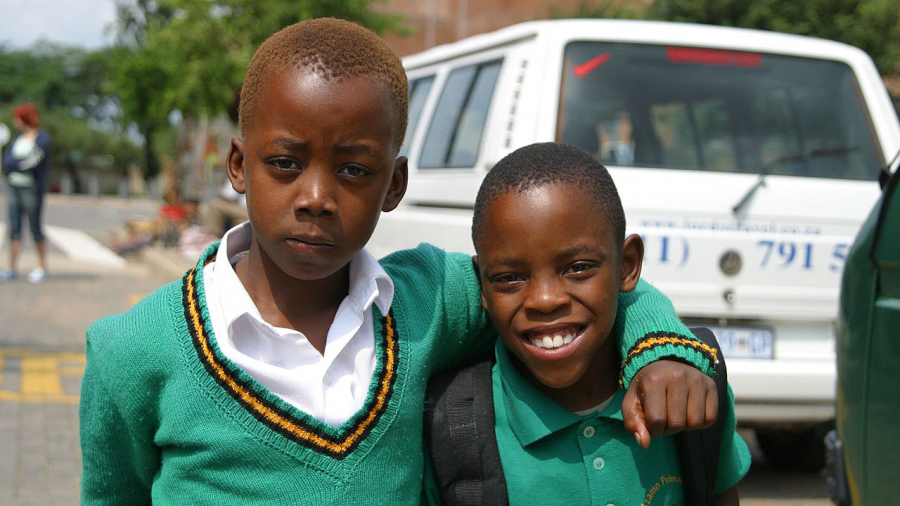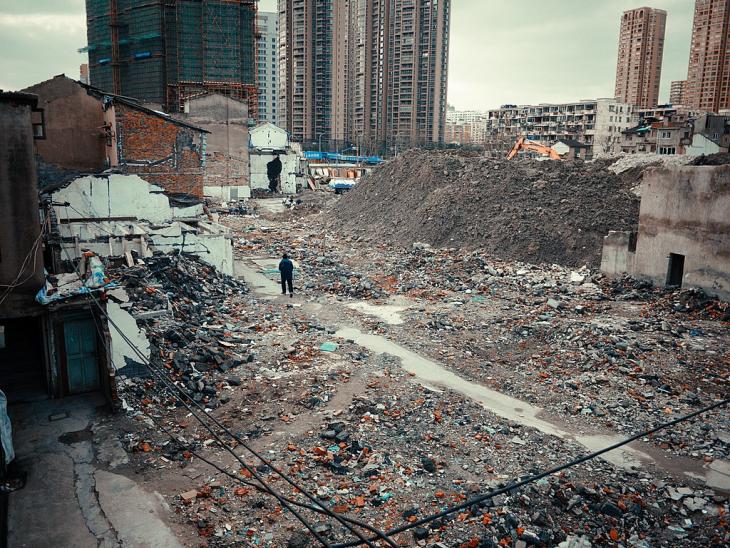
Image by Thomas Sly, Attribution 2.0.
A downloadable version of this lesson is available here:
Participatory futures planning involves a variety of engaged approaches to planning an inhabitable and equitable socio-environmental future, as well as forging pathways toward that vision. As a form of stakeholder engagement that results in the sharing of knowledge and desires, futures planning may give less-empowered groups—such as the poor, women, and children—an opportunity to engage in vision- and decision-making alongside more empowered managers, businesses, and policy makers. This type of planning may be especially important in countries with high levels of inequality in which marginalized groups lack political voice and are forced into livelihoods that damage local ecosystems. (However, governments may blame the poor for small-scale practices like charcoal-making, fuel-wood gathering, and animal grazing, while failing to regulate the broad environmental impacts of profitable industries run by multinational corporations.) In this lesson, learners will design and implement a participatory futures planning session with targeted members of their communities. The ideal outcome is to identify marginalized stakeholders, invite and facilitate their visions of future socio-environmental betterment, and present the insights to local managers.
- Discern among several types of participatory futures planning, including predictive, explorative, and normative planning.
- Identify, profile, and contact individuals and community groups who may lack political influence, and engage with them to imagine and detail their visions of an optimal future.
- Analyze and critique business-as-usual and for-profit futures planning and enrich those worldviews with more equitable and sustainable plans for socio-environmental progress.
Urban Renewal: Have learners view the image to the right. In small groups or among partners, for 3 minutes, discuss the effects of urban development on poorer people who live in places slated for “renewal.” What justifications do empowered groups use to displace these populations (economic, aesthetic, patriotic)? What known effects follow these top-down plans to remake cities (gentrification, displacement)? This image is from China; ask learners to think of examples from their own country that show how marginalized groups may not have a voice in futures planning. (For example, highways cut through urban Black communities for the convenience of commuters, like the Cross-Bronx expressway.) Then, for 2 minutes, have learners suggest ways to engage with vulnerable communities as part of the planning process. What strategies might they use to strengthen the voice of these people? What specific socio-environmental features might improve the quality of life for these groups (e.g., parks, gardens, shade cover, job opportunities, climate-ready construction, water features)?
Participatory Futures Planning: Reducing Environmental Inequality (Two, 75-minute classes + out-of-class interview. Note: these sessions may not be back-to-back since you need time to schedule and conduct the participatory futures planning interview in between class sessions.)
-
As preparation for the session, have learners read the article by Johansson (2021), paying special attention to the highlighted areas. Learners should take notes on the several types of futures planning she discusses, and consider how the more progressive forms—explorative and normative planning— may empower vulnerable communities in their region.
DocumentJohansson 2021 – Highlighted.pdf (462.38 KB) -
(10 min.) After The Hook above, begin the lesson by reviewing the Lesson PPT slides below.
Document -
(20 min.) Divide the class into small groups according to each individual’s special interest group based in their community: children, women, impoverished, BIPOC, queer, and/or intersectional identities. While learners may be interested in the ideas from more than one group, for this lesson, they should choose a specific subset, particularly if they already know of a relevant community group. Once you have formed groups of three to six learners, have them research and list local groups that may provide futures-planning insights. For example, the “children” group might research nature-enthusiast initiatives in local schools or summer camps; the BIPOC group might research local organizations that empower those voices, especially if they have an environmental mission (i.e., community gardens, ethnic food cultures.) Ask each group to identify ~three possible target organizations, listed in order of relevance to planning for environmental futures.
-
(15 min.) As a whole class, have each group present their list of ~three target organizations (~3 min each), and solicit additional ideas and target groups from the collective. This step allows more people to provide insights on local interest groups and enrich the terrain of inclusion.
-
(20 min.) As a whole class, brainstorm the best process for implementing a participatory futures-planning session with a local community group. Include discussion of the following areas:
How to introduce the design, rationale, and outcomes of this exercise to the target group.
Who will facilitate and lead the planning session? Is this a collaborative effort between the lesson group and the local organization’s leadership?
What questions will promote the best insights into this group’s socio-environmental futures? For example:
- What outcomes from this futures planning session would most benefit the target group? How do they perceive their position in relation to the existing power structures in regional governance, industry, and political leadership?
- By 2030, what specific, achievable improvements would they like to see in these areas:
- Green space, parks, and gardens
- Green infrastructure, renewable energy, and transportation
- Food provision, preparation, and participation in food cultures
- Safety, beauty, and inclusion in public spaces
- Job and service opportunities from green economies
- Reduced exposure to toxics in air, water, and the built environment
- By 2050/2100, what’s your dream of optimal progress in those same areas?
-
(5 min.) To end this class session, have small groups agree on a plan to contact their target groups and schedule a time to conduct a participatory futures planning session. Group members should agree on how they will communicate, and they should plan to attend the out-of-class session once it’s scheduled. Instructors should be prepared to liaison between learners and target community groups as needed.
-
Between class sessions, each group will schedule and conduct their participatory futures session. Since it may take several weeks to complete this process, instructors should provide flexibility in scheduling the second class session, when small groups will report their findings.
-
As small groups conduct their sessions, make sure that the tasks are delegated for: introducing and justifying the exercise with the target group; asking questions and facilitating discussion; taking notes and making session recordings (with permission from the target group); reporting back to the target group at the conclusion of the lesson with abundant thanks and contacts with local planning officials.
-
The next class session, when scheduled, will provide the chance for groups to report back on the plans, hopes, and dreams of the socio-environmental future of their target group. These presentations will take most of the 75-minute session, with ~5 groups having ~12 minutes each. Ask groups to prepare the following elements:
Profile of the target group, their current initiatives, and their positionality vis-à-vis existing power and governance structures.
Details of the Q&A and discussion, including notable short- and long-term visions, quotes, and images (as allowed) from the session.
Comparison of short-term, achievable ideas versus long-term, optimal future visions and the group’s sense of how the status quo and existing hierarchies may affect feasibility.
-
(15 min.) With the remaining class time, have a full group discussion that summarizes the findings across target populations. The class may find it appealing to identify common visions across sessions and points of tension or contrast and to situate these ideas for future betterment in relation to the realities of political cycles, funding, competing priorities, and entrenched power inequities. Identify the best ~three ideas across sessions and research potential contacts in local government to promote them.
-
As homework, have each group contact that political representative with a summary of the participatory planning exercise, the session’s insights, and details of the initiative. Copy the leader of the community group and continue advocacy for this idea as time and resources allow.
-
Introduction to Futures Thinking in Socio-Environmental Systems
This SESYNC learning video, written by Dr. Jaime Ashander, provides an introduction to futures thinking, sometimes called scenario analysis or modeling. It covers the features of socio-environmental systems that make analyses of the future difficult, the purpose of conceptualizing or modeling futures, and the three main approaches for doing so. It would also be useful to show to groups or pre-assign prior to this lesson because it is clear and visually appealing.
Ashander, J. (2022, January 5). Introduction to Futures Thinking in Socio-Environmental Systems. SESYNC. https://www.sesync.org/resources/introduction-futures-thinking-socio-environmental-systems
-
Advancing the potential impact of future scenarios by integrating psychological principles
This conceptual article integrates psychology into participatory futures planning by casting light on cognitive bias, heuristics, and psychological distance and how these elements affect the success of futures planning. This research is relevant to those interested in knowing how subjective and emotional elements of human thought affect our ideas and perceptions.
Richter, I., Gabe-Thomas, E., Queirós, A.M. et al. (2023). Advancing the potential impact of future scenarios by integrating psychological principles. Environmental Science & Policy, 140, 68-79, https://doi.org/10.1016/j.envsci.2022.11.015
-
Planning for a Changing Climate: Climate-Smart Planning and Management in the National Park Service
This report from the National Park Service provides guidance on how they conduct futures planning for park management in the context of climate change pressures on the ecology of the parks. The report covers planning, assessment, evaluation, adaptation, and implementation and provides case studies from many parks across the USA and its territories.
National Park Service (NPS). (2021). Planning for a Changing Climate: Climate-Smart Planning and Management in the National Park Service. NPS Climate Change Response Program, Fort Collins, CO. https://irma.nps.gov/DataStore/Reference/Profile/2279647
-
UW Yahara-2070 Undergraduate Module
This in-depth lesson from University of Wisconsin’s environmental studies institute uses Wisconsin’s Yahara River Watershed as a locale for participatory futures planning. Across four class sessions, learners consider scenarios based on differential levels of technology and innovation, community-building, freshwater governance, and disaster recovery. Within each scenario, learners consider the effects by 2070 on lifestyle, community, and environment.
Wardropper, C. (n.d.). Yahara-2070 – Undergraduate Module: Social & Environmental Futures. University of Wisconsin-Madison. https://wsc.limnology.wisc.edu/yahara2070/undergraduate-module
